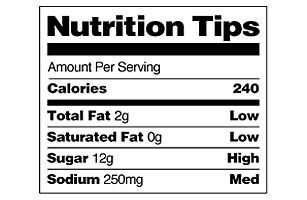
What It Is: The Nutrition Labeling and Education Act of 1990 mandates that all pre-packaged food products be labeled with the amount of total fats, saturated fats, trans fats, cholesterol, sugars and other nutrients. Products also need to list all its ingredients in the order of concentration.
Pros: The format is identical across products, so consumers don't have to deal with a number of different systems. In addition to listing the actual amount of nutrients contained in grams or milligrams, the label also shows the percentage of daily nutrients a person gets from each serving.
Cons: The label is not detailed enough. For instance, it fails to show how much sugar is natural and how much is added artificially. Also, all nutrients (good and bad) are presented in equal fonts, which is not as helpful as it could be. But the FDA is working on an updated Nutrition Facts panel, which would be more readable and brought in line with current public-health concerns. "The Nutrition Facts label was originally addressed to reduce incidence of heart disease. It was not designed to address the problem of obesity," says Bruce Silverglade, director of legal affairs at the advocacy group Center for Science in the Public Interest (CSPI).
The CSPI recommends the following changes to the Nutrition Facts label:
• Display the number of calories in each serving and the entire package in bold, large type
• Print the amount of fats and added sugars in bright red type, so it stands out
• Include caffeine content
• Separate the ingredient list from the Nutrition Facts panel
• List ingredients using upper and lower-case letters; all capital letters are hard to read
• Break ingredients down into three categories: "Major ingredients"; "Contains less than 2% of..."; "Allergy causing ingredients"
• Clarify the ingredients section by consolidating, and eliminating ingredient names that seek to confuse (not everyone knows that all "corn syrups" are simply added sugars)
• Show percentage of key ingredients by weight (Froot Loops are 40% sugar)